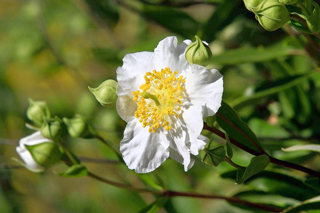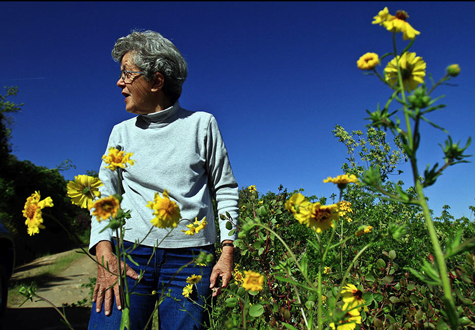Human Flower Project
Elites, Wildflowers, Conservation
How does wildlife preservation come about? Two examples suggest it’s the exertion of human wealth and power, not the threat of natural or even cultural extinction.

Carpenteria californica blooming at the Mary Elizabeth Miller Preserve near Prather, California.
Photo: Irfan Khan, for LA Times
What does it take to save a flower, an acre, a mountain, a cultural region?
Diana Marcum’s fascinating story for the Los Angeles Times is a microcosm of conservation history, recounting the the survival of Carpenteria californica, a rare white wildflower of the Sierra foothills.
It was “discovered” by a 19th century explorer, John Fremont, who lost his way back to the original wild clump. Later a Swedish scientist came upon the plant, collected seed, and sent it to Kew Gardens, where Carpenteria californica was grown into showy specimens, a wonder for horticultural pros and visiting amateurs.
Carpenteria’s homeland in Fresno County was purchased by two “Utopian” sisters, who eventually amassed 1500 acres in the area. One of them took a special interest in the wildflower and came to consider it her private emblem of peaceful resistence during World War I.
The tale goes on…. Crucially, it involves other California elites—wealthy landowners, intellectuals and philanthropists. As we read Marcum’s account, it’s clear that through their resources of leisure time, money, organizational experience, and clout, they were able to create a nature preserve on the plant’s habitat. In league with the national Nature Conservancy, the Mary Elizabeth Miller Preserve was founded.

Peg Smith, one of the conservationists who helped create a nature preserve in the habitat of Carpenteria californica
Photo: Irfan Khan, for LA Times
Whew. The future of Carpenteria californica seems assured.
This story is especially compelling now, as the March on Blair Mountain has just concluded in southern West Virginia. Last week some 400 protesters—trade unionists, environmentalists, neighbors, historians—marched 50 miles to the mountain, holding a rally over the weekend. They demanded protection of this spot and other Appalachian lands from mountaintop-removal strip mining and support of Appalachia’s working people.
Blair Mountain is sacred ground. But has most of the nation even heard of it?
Alex Bloedel writes for the Daily Yonder,
“In 1921, upwards of 10,000 coal miners gathered arms, hijacked a train, and fought against a local police force of about 2,000 – led by Logan County Sheriff Don Chafin and funded by the Logan County Coal Operators Association – before peacefully surrendering to federal military forces sent by President Harding. Hundreds of miners were killed and injured by Chafin’s men and by privately-hired bomber planes in what was one of the largest civil uprisings in American history. ”
Robert F. Kennedy, Jr. of New York, an environmental lawyer and one of the speakers at the Blair Mountain rally, said Saturday, “If you buried 25 feet of a Hudson River stream, we’d put you in jail. What they’re doing is illegal, and they couldn’t get away with it except that they have been able to muzzle the press and dismantle our democracy.”
Is that really it? Or is it that Kennedy and his neighbors along the Hudson, like the Utopians in the western Sierra, have the power to curb the media? Is it that there’s coal inside the Appalachian hills and the region is so economically desperate that many of its leaders—and residents—have been willing to support strip mining, even as it destroys their homeland?
Clearly, a determined group of wealthy and well educated Californians have been able to save an endangered wildflower but an Appalachian mountain, the site of one of the greatest confrontations in U.S. labor history, can’t be protected from decimation. In 2009, Blair Mountain was added to the National Register of Historic Places. “Nine months later, after pressure from coal companies on state agencies, it was removed from the register.”

Wildflowers blooming on Blair Mountain in West Virginia
Photo: jimsphotos
Mountaintop removal mining blasts off the top of hills to expose coal seams. It not only destroys local plants and animals but poisons local waterways, changes the landscape forever, and endangers human life, too. All these can be and have been sacrificed in the name of coal production.
If trade unionists and southern West Virginians lack the power of California and New York elites, can a rare blossom—or more than one—be found blooming this June on the side of Blair Mountain?
Who can find it, send its seed to Kew, grow it for the world to see? And who can find a livelihood to compete with mining in West Virginia, tipping the balance in this fight against mountain-top removal?


An essay that is simultaneously depressing and inspiring.
The argument about wealth and power seems to hold at least for NYC Parks where the wealthy Central Park Conservancy has fantastically renovated its namesake while other city parks run down and languish, especially those in economically-depressed neighborhoods.
If West Virginia became the second home-landia for elites would that stop the mountain-top removal mining?